In this page, you can find the complete solutions of the first
exercise of Pair of Straight Lines chapter from Basic Mathematics
Grade XI book published and distributed by Sukunda Pustak Bhawan.
In the above-mentioned book, analytical geometry is the 10th chapter
and has two exercises only: Normal Exercise and Additional Questions.
Out of which, this is the solution of the first exercise or normal
exercise.
Check: Basic Mathematics Grade 11 (Sukunda Publication) Guide:
Grade 11 Basic Mathematics by Sukunda Pustak Vawan Notes and Solutions | Nepal
Also Check: Pair of Straight Lines Additional Exercise Solutions
Grade 11 Pair of Straight Lines Additional Exercise Solutions | Basic Mathematics Grade XI by Sukunda Pustak Bhawan
Disclaimer:
Answers mentioned here are not solved by teachers. These are the
solutions written by a student of Grade 11. Answers are all correct.
However, the language or process of solving the questions might be
informal and in examinations, you might have to add little more
language and show more calculations than what has been done here.
So, we highly encourage you to view these solutions as guide rather
than just copying everything mentioned here. Few questions have been
typed while most of them have been updated as pictures.
a) $x + y =0, x + 2y =0$
Solution:
Here,
Here,
Equation of lines are $x + y = 0$ and $x + 2y = 0$
Now,
Single equation representing the line pair is $\implies (x+y)(x+2y) =
0$
$or, x(x +2y) + y(x +2y) =0$
$or, x^2 + 2xy + xy + 2y^2 = 0$
$\therefore x^2 + 3xy + 2y^2 = 0$
b) $ax - by= 0, bx + ay =0$
Solution:
Here,
Equation of lines are: $ax-by = 0$ and $bx+ay = 0$
Now,
Single equation representing the line pair is $\implies (ax-by)(bx
+ay)=0$
$or, ax(bx + ay)-by(bx + ay) = 0$
$or, abx² + a²xy - b²xy - aby² = 0$
$\therefore abx² +(a²-b²)xy - aby²= 0$
c) $x + y+2 = 0, x + 2y + 1 = 0$
Solution:
Here,
Equation of lines are: $x + y + 2=0$ and $x +2y + 1 = 0$
Now,
Single equation representing the line pair is $\implies (x + y+2)(x + 2y
+1) = 0$
$or, x(x + 2y +1) + y(x + 2y +1) + 2(x +2y+1) = 0$
$or, x² + 2xy + x + xy + 2y² + y + 2x + 4y + 2 = 0$
$or, x² + 3xy + 3x + 5y + 2y² + 2 = 0$
2. Determine the lines represented by each of the following equations:
a) $x^2 - 2xy = 0$
Solution:
Given,
$x^2 - 2xy = 0 \implies x(x-2y) = 0$
So,
Line 1 is $x = 0$
Line 2 is $x - 2y = 0$
b) $x^2 - 5xy + 4y^2 = 0$
Solution:
Given,
$x^2 - 5xy + 4y^2 = 0 \implies (x-4y)(x-y) = 0$
So,
Line 1 is $x - 4y = 0$
Line 2 is $x - y = 0$
c) $xy - 3x + 2y -6 =0$
Solution:
Here,
$xy - 3x + 2y - 6 = 0 \implies x(y-3) + 2(y-3)=0$
$or, (x+2)(y-3) =0$
So,
Line 1 is $x + 2 =0$
Line 2 is $y -3 =0$
d) $x^2 + 2xy +y^2 - 2x - 2y -15 =0$
Solution:
Here,
$x^2 + 2xy +y^2 -2x - 2y - 15 = 0$
$or, x^2 + 2xy - 2x + y^2 -2y -15 = 0$
$or, x^2 + x(2y - 2) + (y^2 - 2y -15) =0$
Comparing above equation with general quadratic equation
$ax^2 + bx + c = 0$
We get,
$a = 1$
$b = 2y - 2$
$c = y^2 - 2y -15$
Using formula,
$x = \dfrac{ -b \pm \sqrt{b^2 - 4ac}}{2a}$
$or, 2ax = -(2y-2) \pm \sqrt{(2y-2)^2 - 4*1*(y^2 -2y-15)}$
$or, 2*1*x = 2 - 2y \pm \sqrt{4y^2 - 8y + 4 - (4y^2 - 8y - 60)}$
$or, 2x = 2 - 2y \pm \sqrt{4y^2 - 8y + 4 - 4y^2 + 8y +60}$
$or, 2x + 2y -2 = \pm \sqrt{64}$
$or, 2x + 2y - 2 = \pm 8$
Taking positive sign, we get,
$or, 2x + 2y - 2 =8 \implies 2x + 2y - 10= 0$
$\therefore x + y - 5 = 0 $
Taking negative sign, we get,
$or, 2x + 2y - 2 = -8 \implies 2x + 2y +6 =0$
$\therefore x + y + 3=0$
Hence, the required equations of lines are $x + y - 5= 0$ and $x + y + 3
=0$.
3. Find the angle between following pairs of lines.
a) $x^2 + 9xy + 14y^2 = 0$
Solution:
Here,
Here,
$a = 1$
$h = \frac{9}{2}$
$b = 14$
Let $\theta$ be the angle between the given pair of lines.
We know,
$tan \theta = \pm \dfrac{2\sqrt{h^2 - ab}}{a+b}$
$or, tan \theta = \pm \dfrac{2 \sqrt{ (\frac{9}{2} )^2 - 1 * 14}}{1 +
14}$
$or, tan \theta = \pm \dfrac{2 \sqrt{ \frac{81}{4} - 14}}{15}$
$or, tan \theta = \pm \dfrac{2 \sqrt{\frac{81-56}{4}}}{15}$
$or, tan \theta = \pm \dfrac{2 \sqrt{\frac{25}{4} }}{15}$
$or, tan \theta = \pm \dfrac{2 * \frac{5}{2} }{15}$
$or, tan \theta = \pm \dfrac{5}{15}$
$or, tan \theta = \pm \dfrac{1}{3}$
$\therefore \theta = tan^{-1} \left ( \pm \dfrac{1}{3} \right )$
b) $x^2 - 2xy cot \theta - y^2 = 0$
Solution:
Here,
$x^2 - 2xy cot \theta - y^2 = 0$
Comparing given equation with second degree homogeneous equation $ax^2 +
2hxy + by^2 = 0$, we get,
$a = 1$
$h = -cot \theta$
$b = -1$
Let $\theta$ be the angle between the given lines
We have,
$tan \theta = \pm \dfrac{ \sqrt{h^2 - ab}}{a+b}$
$or, tan \theta = \pm \dfrac{ sqrt{(-cot\theta)^2 - 1(-1)}}{1 +
(-1)}$
$or, tan \theta = \pm \dfrac{sqrt{cot^2 \theta + 1 }}{0}$
$or, tan \theta = \infty$
$or, \theta = tan^{-1} (\infty)$
$\therefore \theta = \dfrac{\pi}{2}$
c) $x^2 - 5xy + 4y^2 + x + 2y - 2= 0$
Solution:
Write the language yourself.
We have,
$a = 1$
$h = - \frac{5}{2}$
$b = 4$
Using formula,
$tan \theta = \pm \dfrac{ \sqrt{h^2 - ab}}{a + b}$
$or, tan \theta = \pm 2 \dfrac{\sqrt{ (-\frac{5}{2} )^2 - 1 * 4}}{1
+4}$
$or, tan \theta = \pm 2 \dfrac{\sqrt{ \frac{25}{4} - 4}}{5}$
$or, tan \theta = \pm 2 \dfrac{\sqrt{{\frac{25 - 16}{4}}}{5}$
$or, tan \theta = \pm 2 \dfrac{\sqrt{\frac{9}{4}} }{5}$
$or, tan \theta = \pm \dfrac{ 2 * \frac{3}{2} }{5}$
$or, tan \theta = \pm \dfrac{3}{5}$
$\therefore \theta = tan^{-1} \left ( \pm \dfrac{3}{5} \right )$

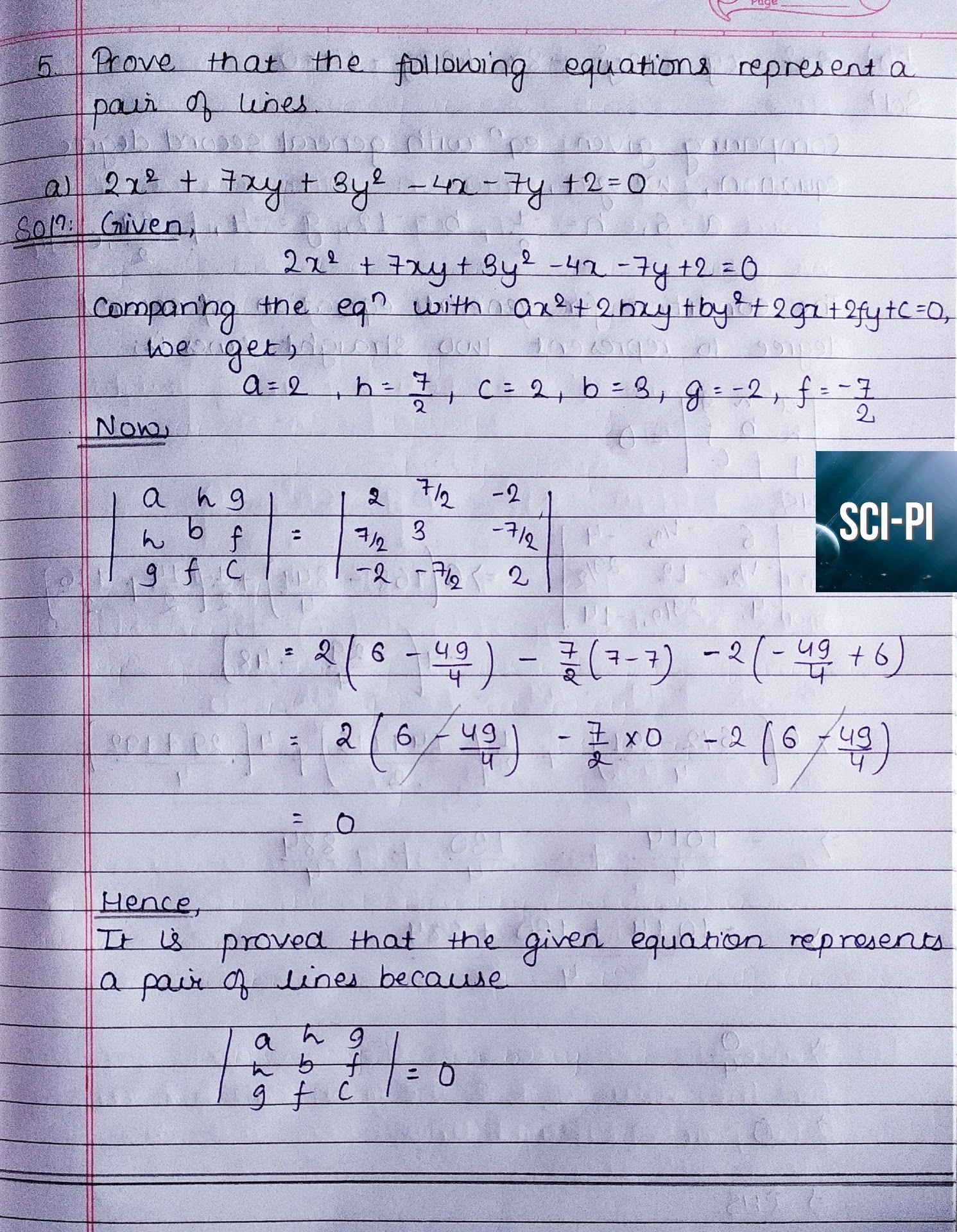
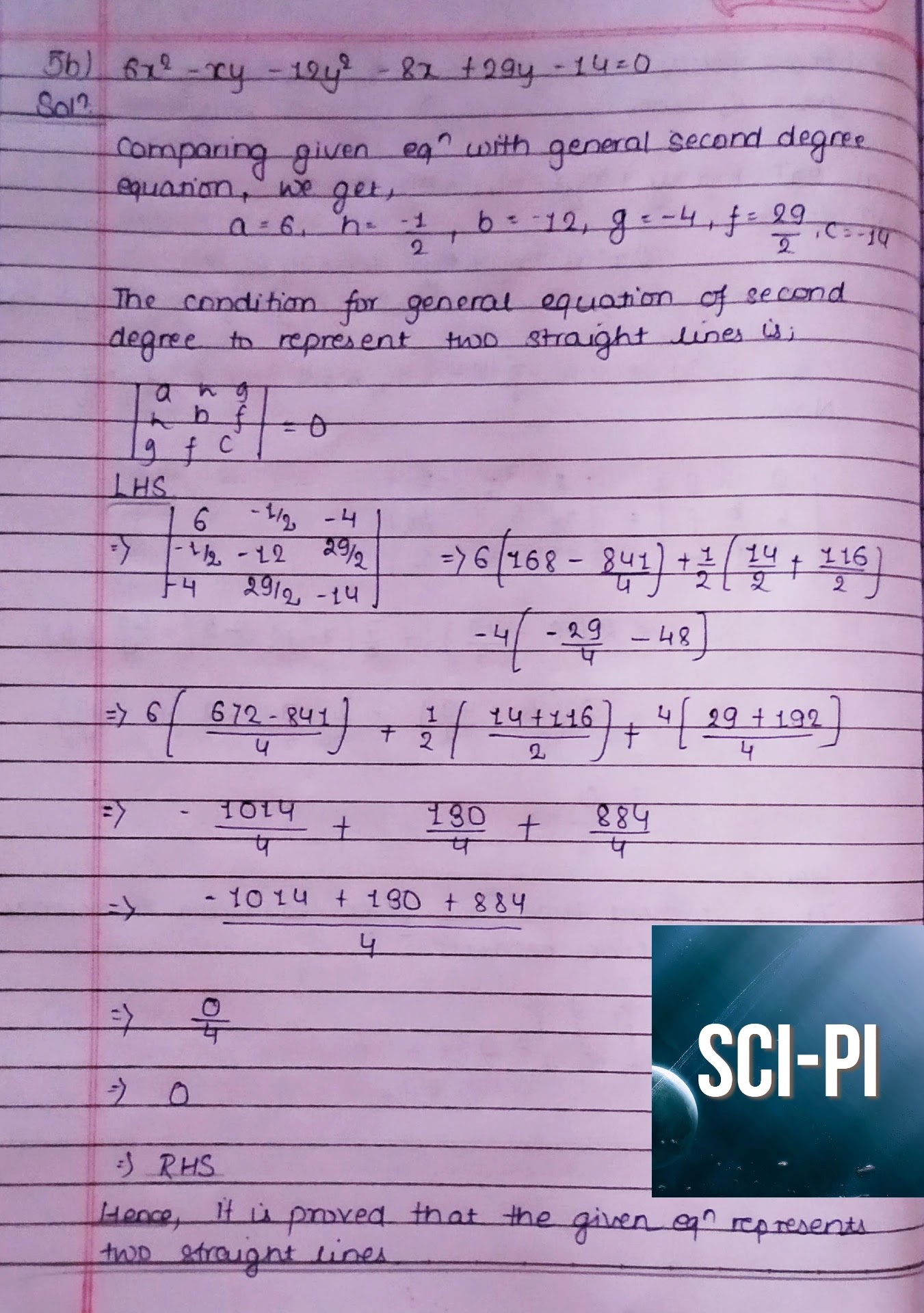
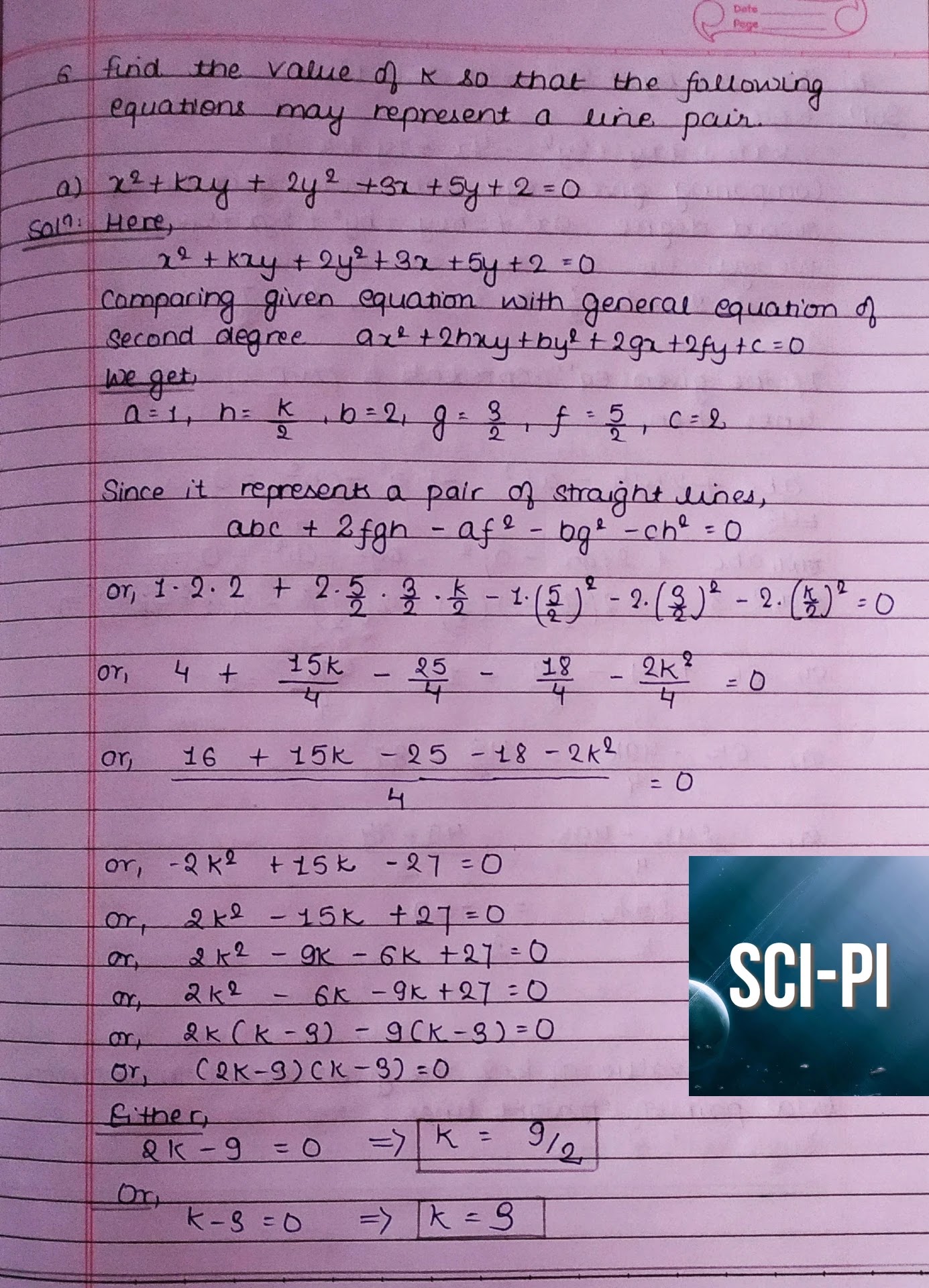

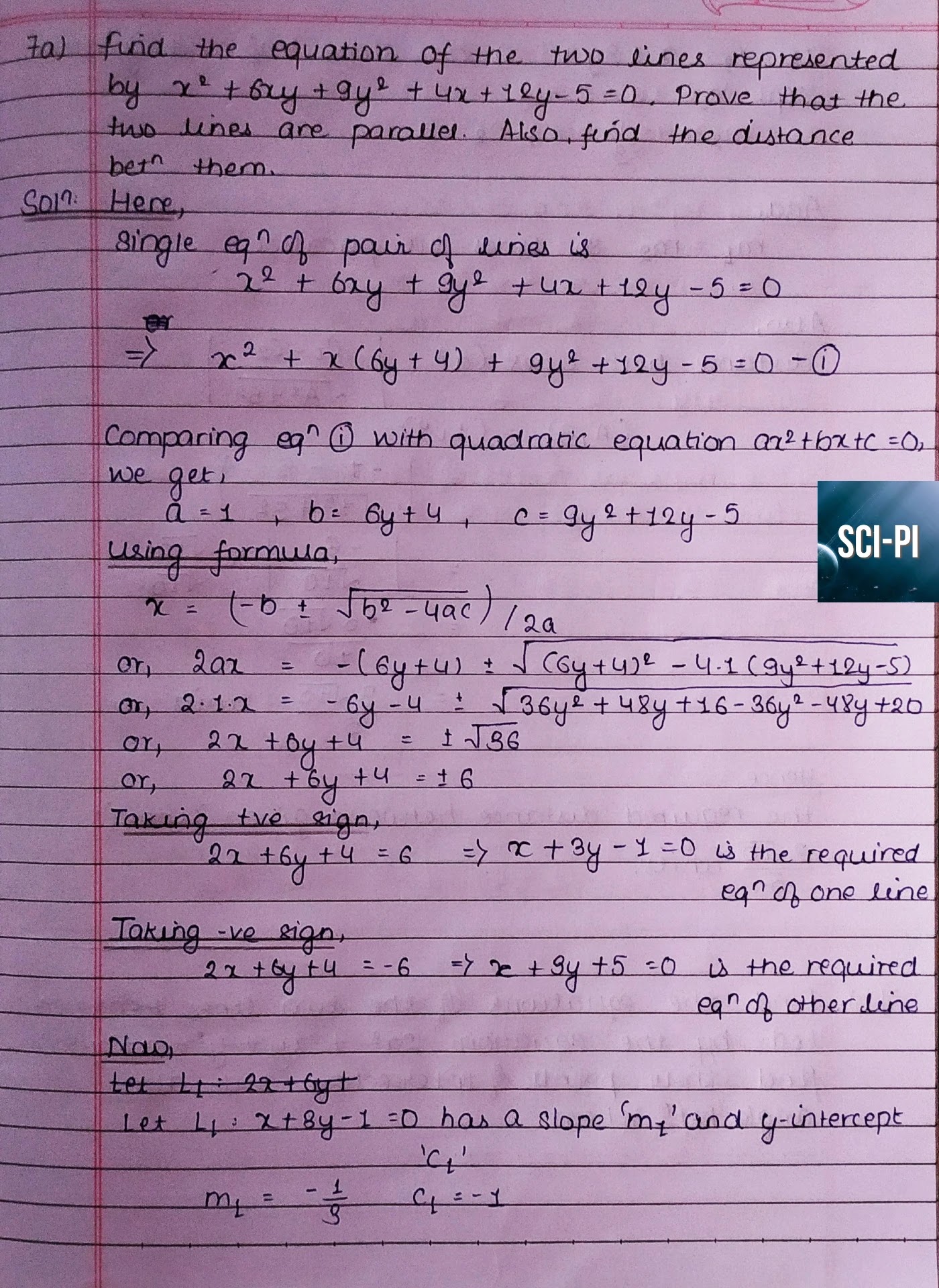
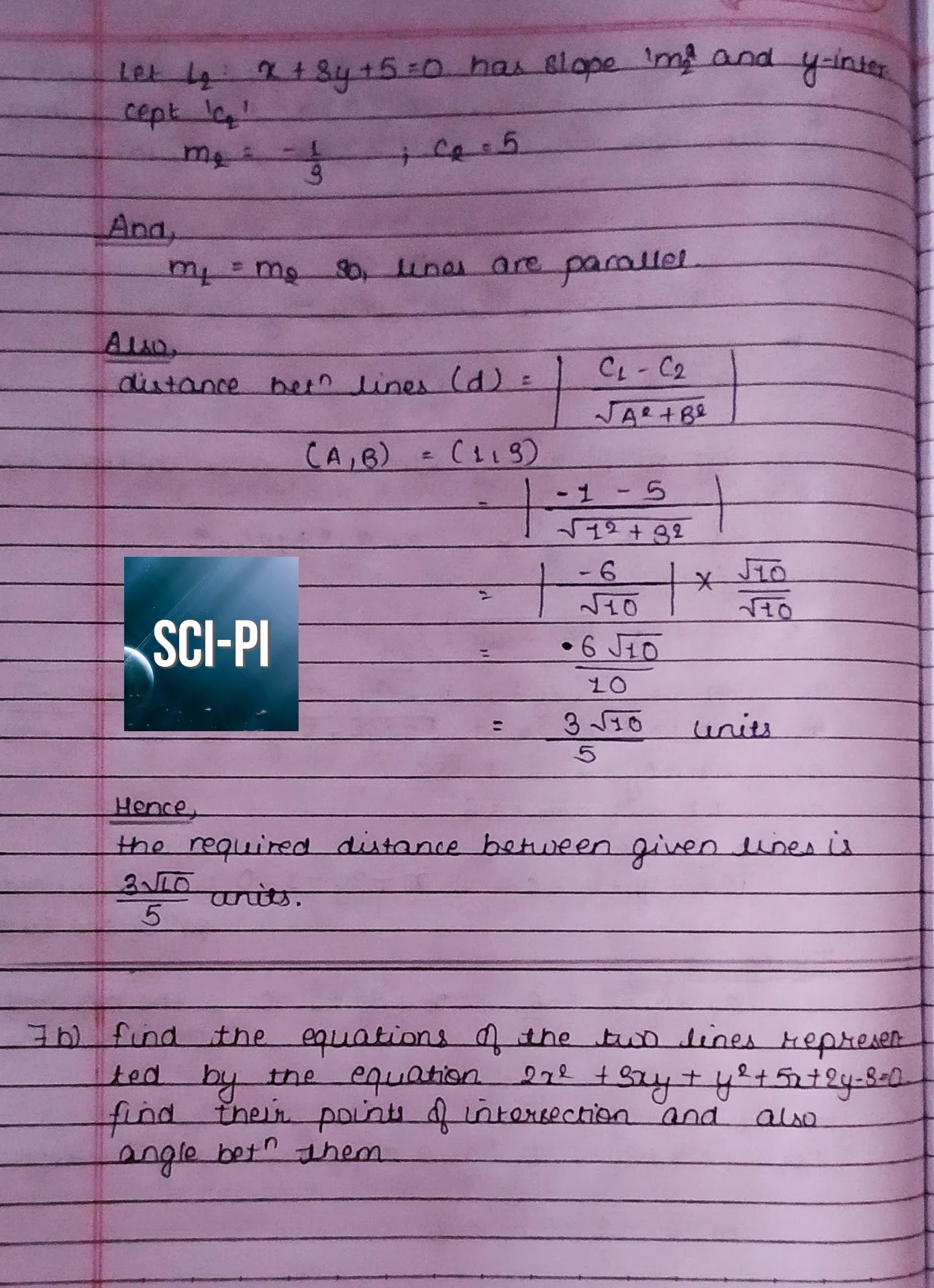

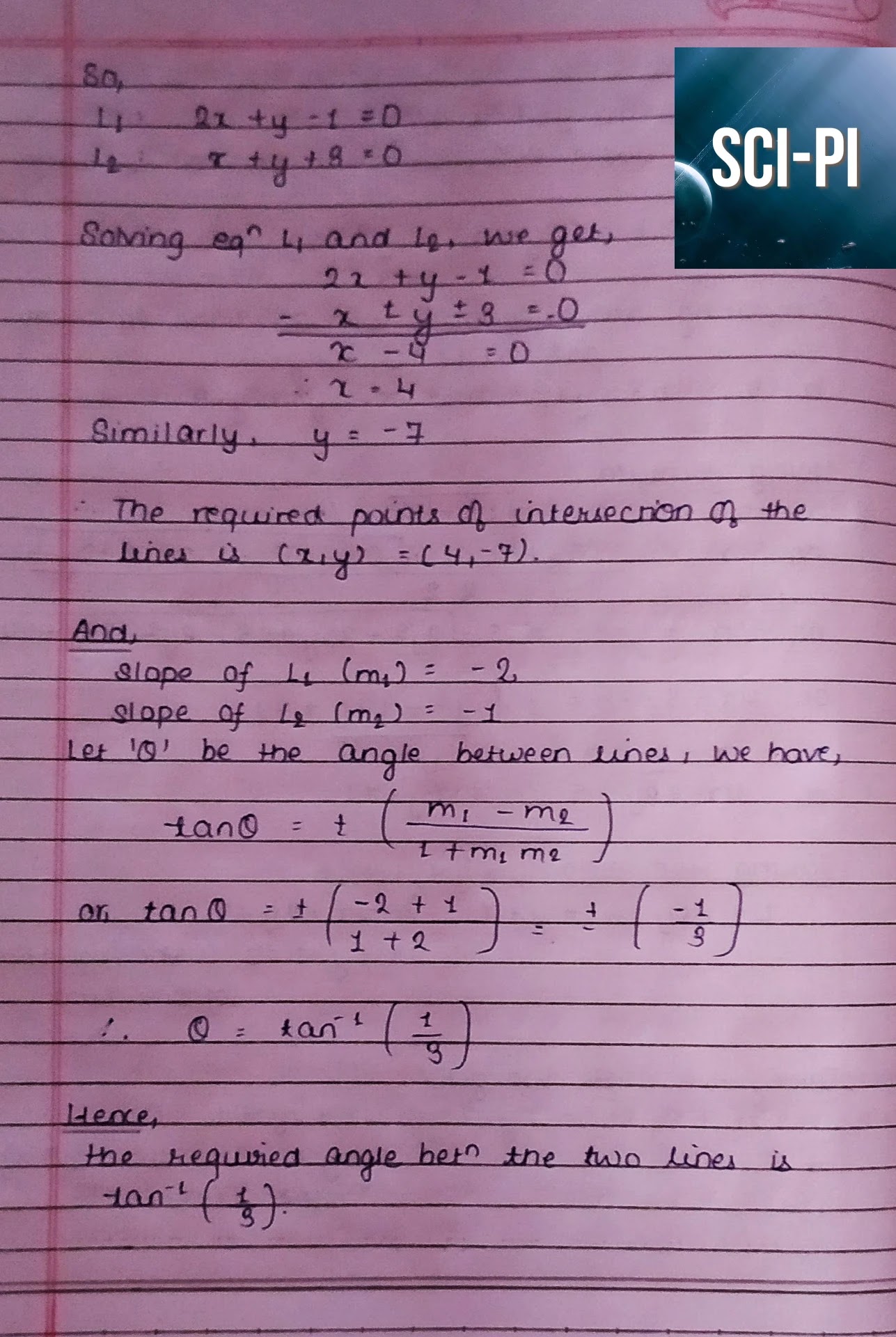

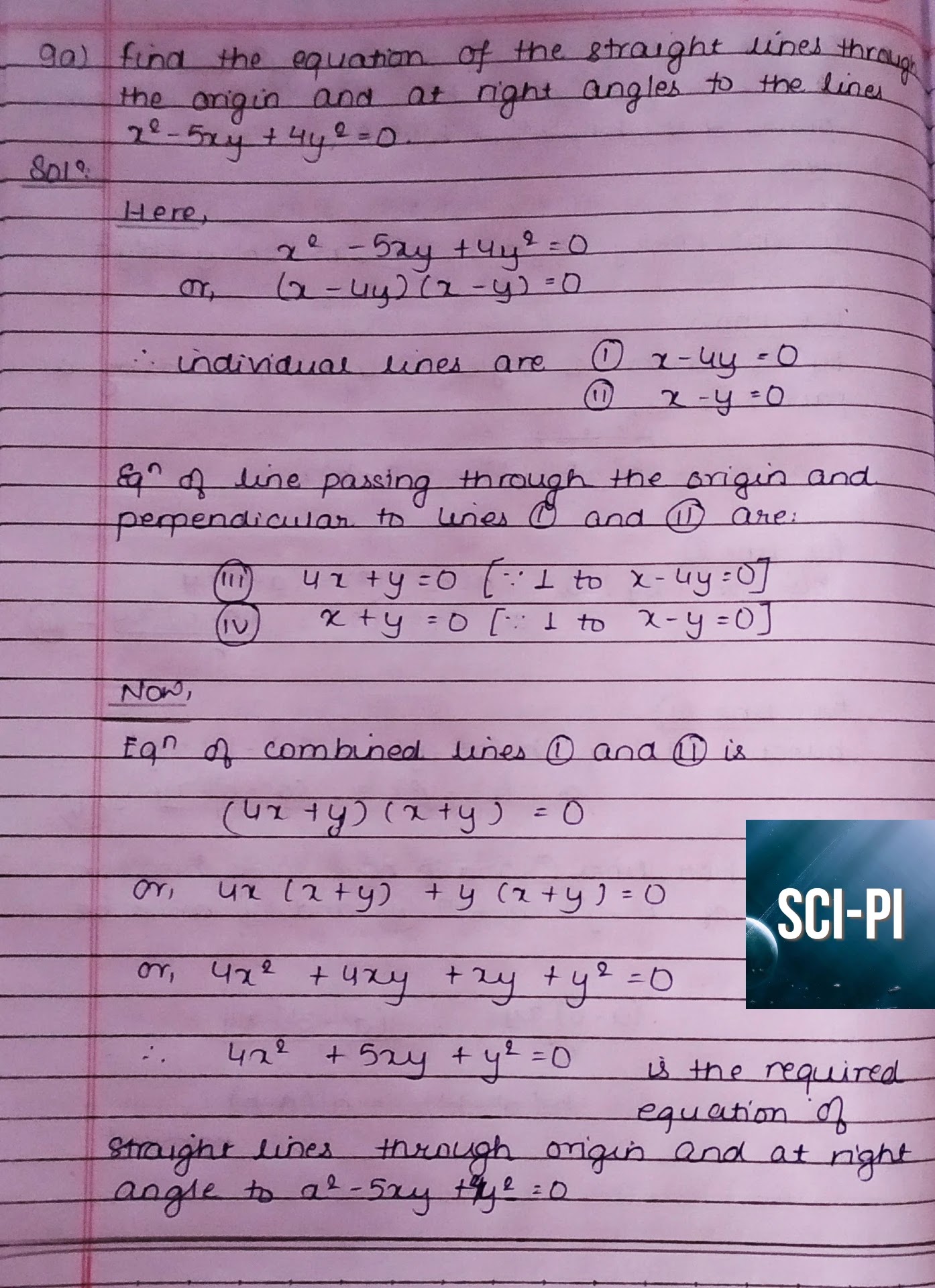
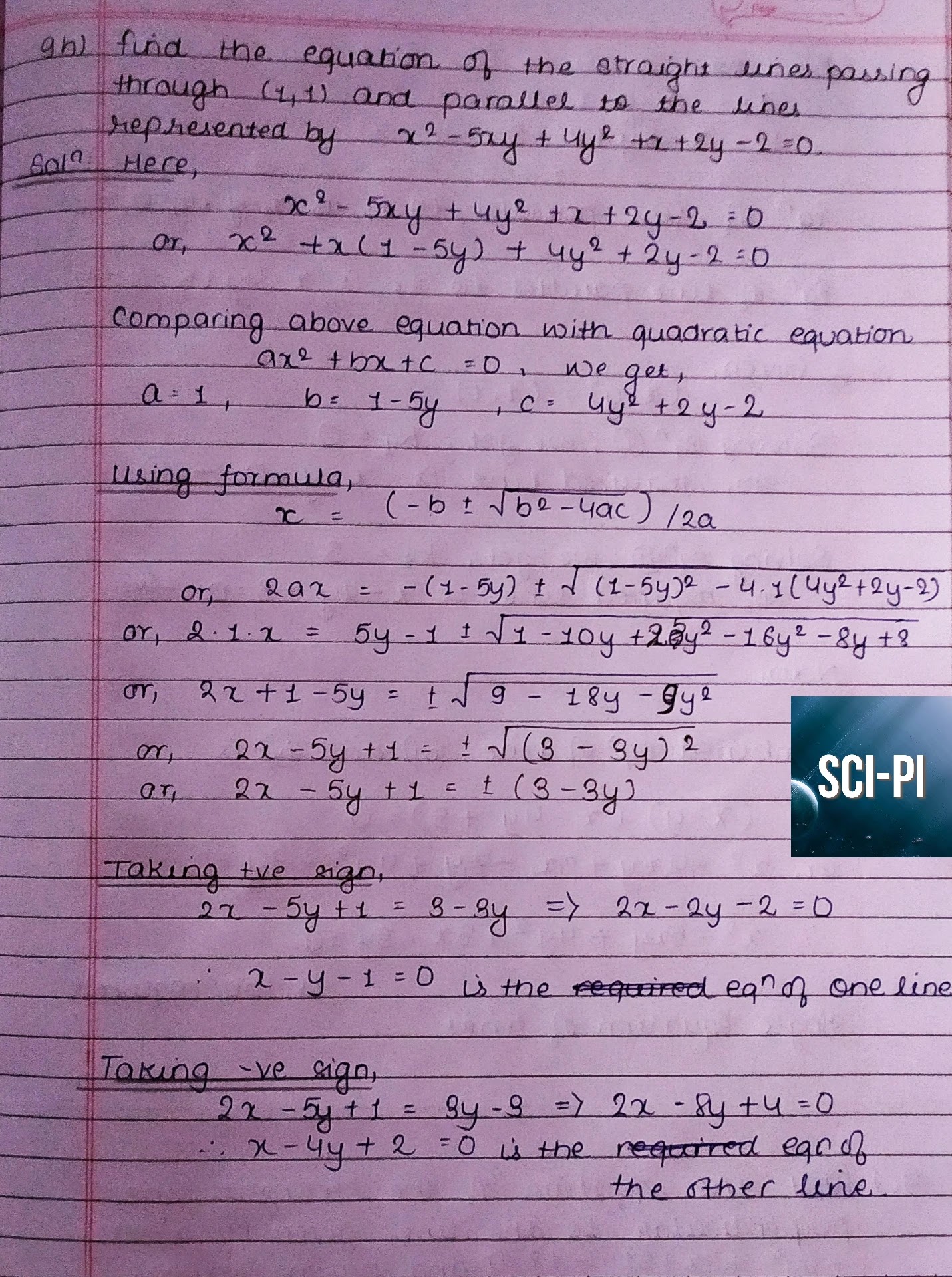
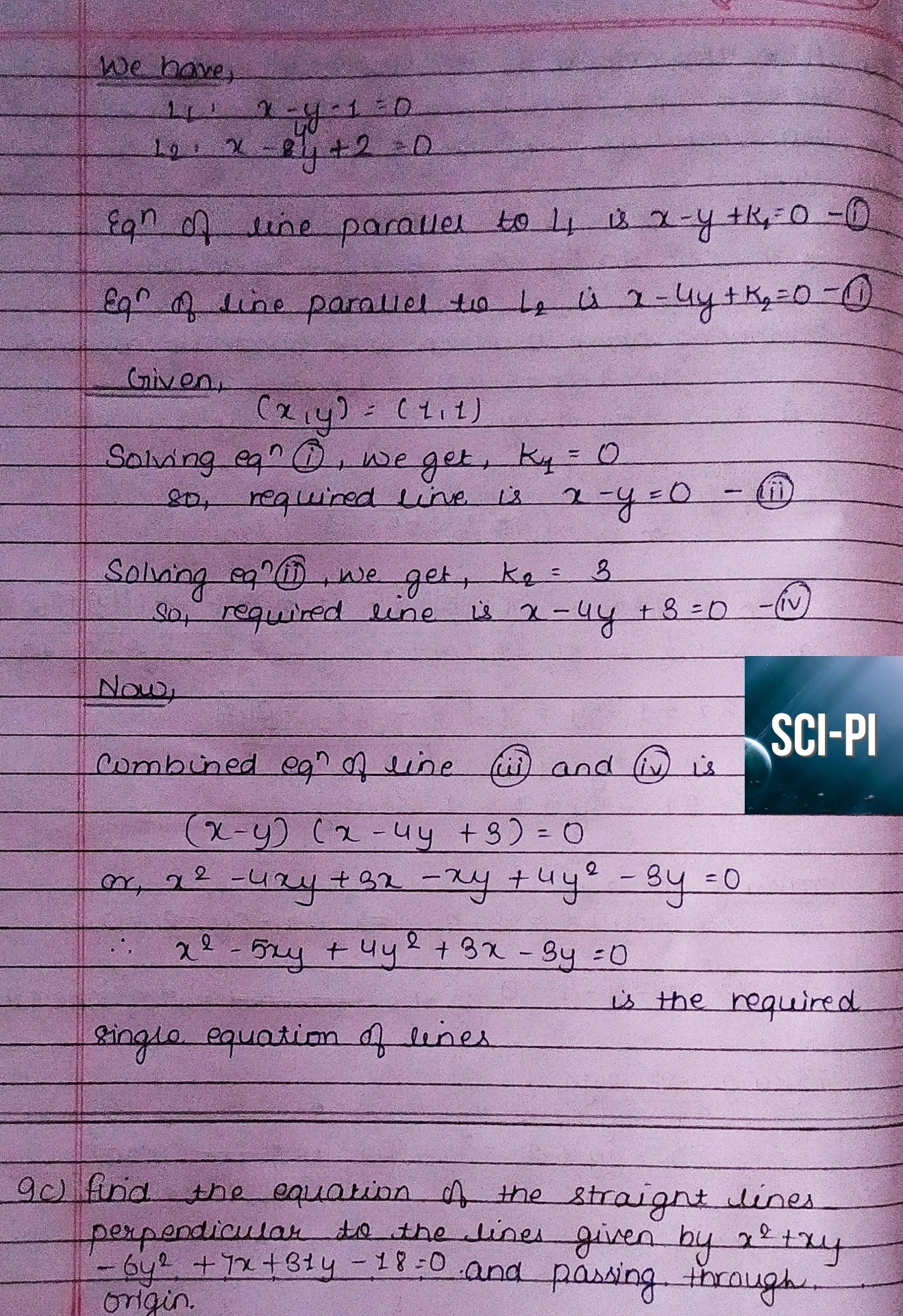
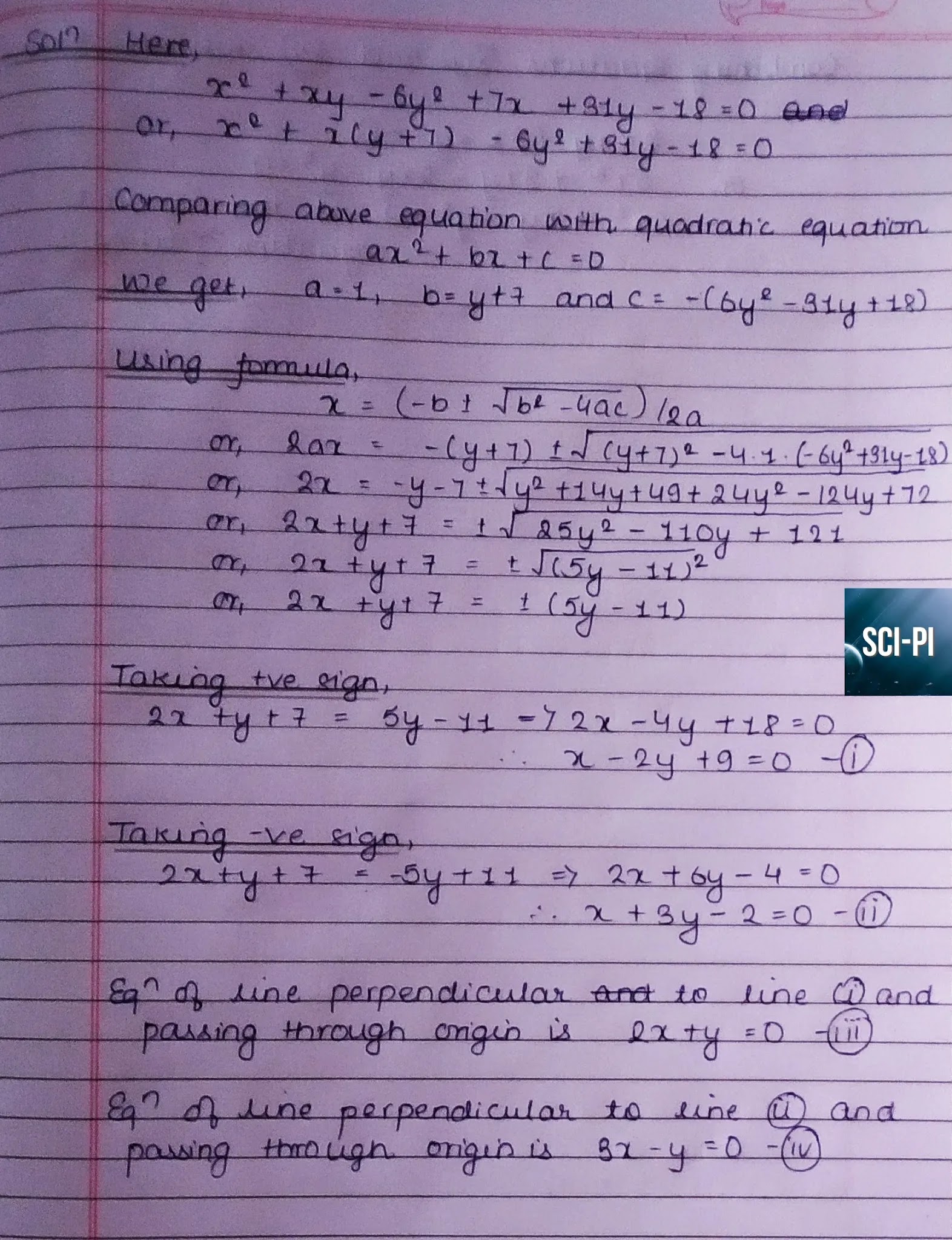
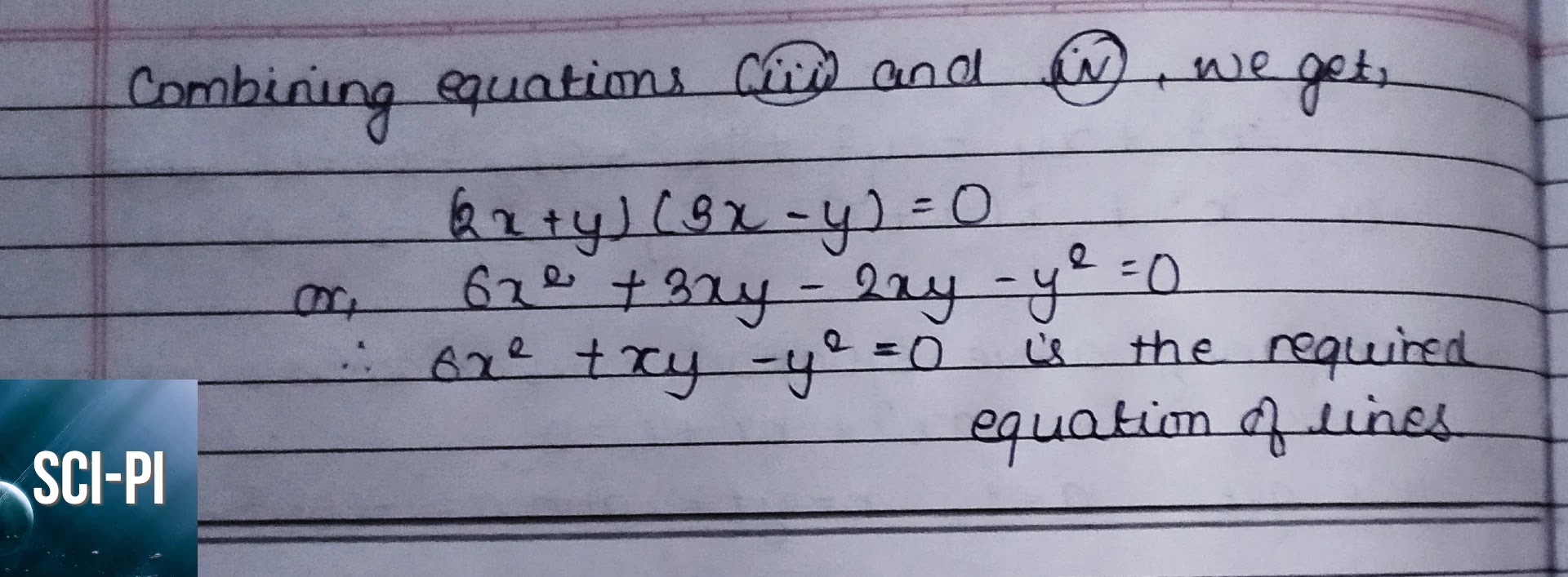
10 a) Show that the lines joining the origin to the point of intersection of the line $x + y = 1$ with the curve $4x²+4y²+4x -2y -5=0$ are at right angles to each other.
Solution:
Given,
Equation of a straight line is $x + y =1$
$or, \dfrac{x + y}{1} = 1$ ---- (i)
Equation of a curve is $4x²+4y²+4x-2y-5=0$
Now,
Making equation (i) homogenous with the help of equation (ii), we get,
$4x²+4y²+2(2x -y)×\dfrac{(x+y)}{1} - 5\dfrac{(x+1)^2}{1^2} = 0$
$or, 4x²+4y²+2{2x(x+y)-y(x+y)} - 5(x²+2xy +y²)=0$
$or, 4x²+4y²+2{2x²+2xy-xy-y²} - 5x²-10xy -5y²=0$
$or, 4x²-5x²+4y²-5y²-10xy +4x²+2xy -2y²=0$
$\therefore 3x²-8xy -3y²=0$
Comparing above equation with homogenous equation of second degree $ax²+2hxy+by²=0$, we get,
$a = 3$
$b = -3$
If the lines represented by second degree equation are perpendicular then the sum of coefficients of x and y must be zero.
$\therefore a + b = 3+(-3) = 0$
Hence, it is proved.
SOLUTIONS BELOW HERE ARE INCOMPLETE
11. Prove that the two straight lines $(x²+y²)sin² \alpha = (xcos \theta -
y sin \theta)^2 $ include an angle 2\alpha$.
Solution:
Given,
$(x²+y²)sin² \alpha = (xcos \theta - y sin \theta)^2 $
$or, (x²+y²)sin²\alpha = x²cos²\theta + y²sin²\theta - 2xy cos\theta
sin\theta$
$or, x²(sin²\alpha - cos²\theta) + y²(sin²\alpha - sin²\theta) + xy sin
2\theta = 0$
Here,
$a= (sin^2 \alpha - cos^2 \theta)$
$b = (sin^2 \alpha - sin^2 \theta)$
$h = sin 2 \theta$
Let $\theta$ be the angle between the given pair of lines, we know,
$tan \theta = \pm \dfrac{h^2 - ab}{a + b}$
$or, tan \theta = \pm \dfrac{(sin 2\theta)^2 - (sin^2 \alpha -
cos^2\theta)(sin^2 \alpha - sin^2 \theta)}{sin^2 \alpha - cos^2\theta +
sin^2 \alpha - sin^2 \theta)}$
$or, tan \theta = \pm \dfrac{(sin 2 \theta)^2 - (sin^4 \alpha - sin^2
\alpha sin^2 \theta - sin^2 \alpha cos^2\theta + sin^2 \theta cos^2
\theta)}{2 sin^2 \alpha - (sin^2 \theta + cos^2 \theta)}$
$or, tan \theta = \pm \dfrac{(sin2 \theta)^2 - {sin^2 \alpha (sin^2 \alpha
- cos^2 \theta) - sin^2 \theta(sin^2 \alpha - cos^2 \theta)}{2sin^2 \alpha -
1}$
$or, tan \theta = \pm \dfrac{(sin2 \theta)^2 - {(sin^2 \alpha - sin^2
\theta)(sin^2 \alpha - cos^2 \theta)}{-(1 - 2sin^2 \alpha)}$
$or, tan\theta = \pm \dfrac{
About the Textbook:
Name: Basic Mathematics Grade XI
Author(s): D.R. Bajracharya | R.M. Shresththa | M.B. Singh | Y.R.
Sthapit | B.C. Bajracharya
Publisher: Sukunda Pustak Bhawan (Bhotahity, Kathmandu)
Telephone: 5320379, 5353537
Price: 695 /- (2078 BS)
Buy this book: Basic Mathematics : Grade XI – Sukunda Publication


0 Comments
You can let us know your questions in the comments section as well.